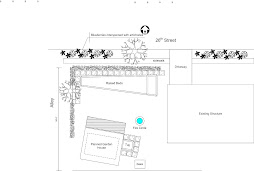Recently I had the pleasure of reviewing architecture student midterm garden design projects. The assignment was geared for sustainability. The projects I looked at revealed a high degree of variety and creativity. Some were quite lovely.
One thing that struck me, however, was how differently the students interpreted what 'sustainability' means. As I realized this, I began to prod a bit by asking questions: "What does sustainability mean?", "What were the sustainability objectives for your design?"
Their good work notwithstanding, the answers given by the students were surprisingly vague and gave opportunity to reflect on how I consider and pursue (or don't!) sustainability in my own garden. The conversations which resulted surfaced a couple of basic things perhaps worth sharing here.
First, sustainability is about balancing inputs and outputs. Better still, it's about zeroing out inputs and outputs within a defined space. If I'm dragging lots of materials into my garden (guilty as charged!), then I'm not balanced. If I'm hauling out lots of materials, I'm not balanced. If I'm consuming more food than I'm producing, I'm not balanced.
I realize this is not a very forgiving definition of sustainability, but it is simple, direct, and measurable. The latter qualities make it a sturdy guidepost for design choices, lifestyle choices, etc. Not to be harsh, but it strikes me that without such a clear and basic way of talking about sustainability, the word and the concept become mostly about style and intentions and not much at all about creating lasting ways of living.
Second, and in a related sense, sustainability always has a specific scope. There's no such thing as generic 'sustainability'. Scope defines the specific realm within which inputs and outputs are zeroed out. It can be thought of both in terms of what things it covers (e.g. soil, water, food, tools, etc.) and in terms of the geography (garden plot, neighborhood, city, region, etc.) which bounds it.
So, I could aim for soil sustainability by reprocessing garden waste to create all of my own amendments such as compost, manure, and the like. I could go for water sustainability by capturing and storing all the water I require. I could go for food sustainability by growing all I eat. But I could also scope my sustainability efforts around soil, water, and food to extend throughout my neighborhood (by trading with neighbors), my city, my region, etc.
In a very practical, daily sense, being able to spell out my sustainability objectives in terms of what they cover and over what geography they apply is helpful to me in identifying specific courses of action that make more sense than others. There are lots of things I could do. Knowing this year, for example, that I want to stop removing large quantities of biomass and bringing in similar quantities of soil amendments gives me something specific to work on around compost, mulching, etc. Next year it could be about seed and start sustainability. Recognizing the geography within which I intend to zero out tells me who I need to help and get help from.
I live a long way from sustainability. Recognizing that makes it clear that getting to sustainability is not just about lifestyle. There's really no daily solution that'll get me there. Rather, a lot of my 'infrastructure' is just plain wrong. That means re-design. Which brings me back to the wonderful and creative design students I had the pleasure to meet recently. They enjoy super opportunities to shape spaces in ways which can actually enable or enhance the likelihood that people will live in sustainable and durable ways....or not. Clarity about what that actually means is a good starting point.

No comments:
Post a Comment